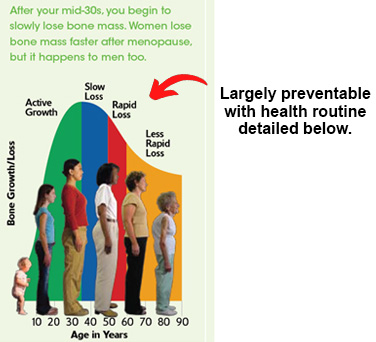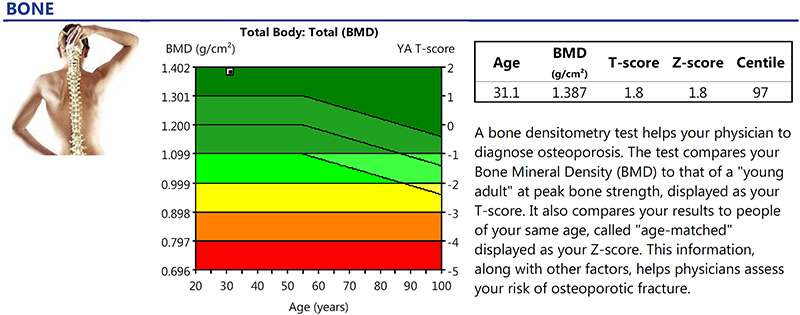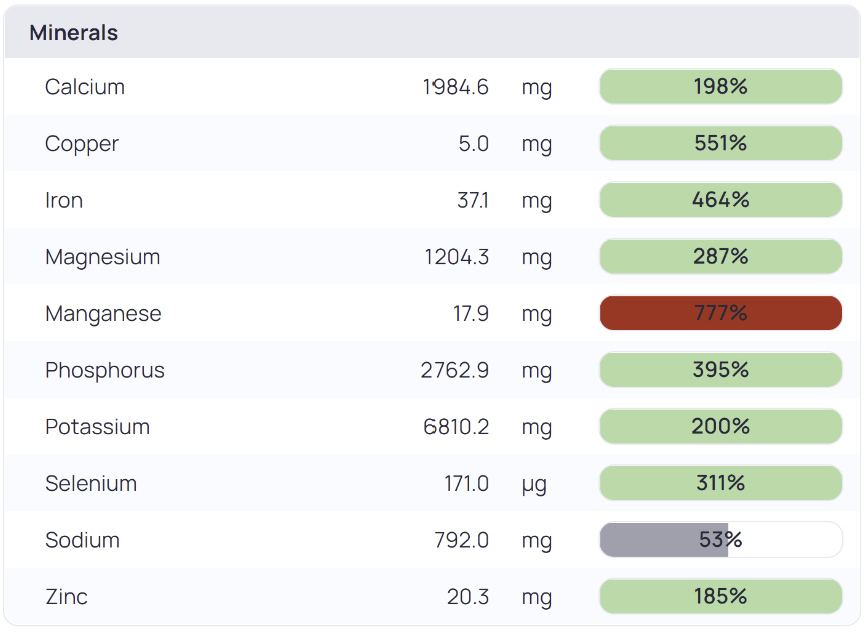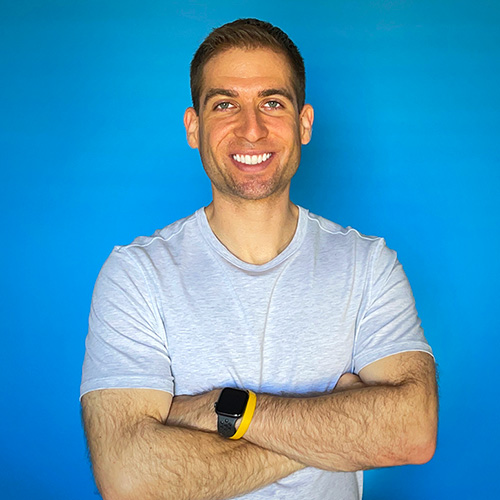As a 31-year-old man, I did what any 65-year-old woman should do. I got DEXA’d. I assessed my bone mass and density to gauge bone health. I then compared those results to healthy populations to determine optimal bone density values. What is bone mineral density? Why is preventing osteopenia so important? And what lifestyle routine can you follow to optimize bone health? Well, let’s get into it!
Why Bone Health Matters
Osteopenia is when your bones are weaker than they should be. They’re becoming brittle. And without intervention they’re destined for osteoporosis. Osteoporosis is when bones are brittle enough to break easily. A fall, bump, or even a cough becomes dangerous. Surprisingly, 1 in 5 men and 3 in 5 women above the age of 50 have osteopenia [1]. Or weak bones. By the age of 65, those 20% of men and 60% of woman now have osteoporosis [2]. Brittle bones susceptible to a cough. After the age of 50, bone density falls off a cliff decreasing by over 1% per year [1].

If that wasn’t bad enough, the resulting bone fractures are even worse. Hip fractures are deadly. In the first year following a hip fracture after the age of 50, survival rates are a mere 60% [1]. In addition, they’re among the most frequent causes of disability worldwide. And despite postmenopausal woman being 4x more susceptible to brittle bones, men are more susceptible to dying from a bone fracture [4]. Although being a 31-year-old male, puts me at little risk currently, I do have one major risk factor.
Surprising Risk Factors
I’m lean. Surprisingly, being overweight is beneficial for bone density. I think this is the first time I’ve praised being fat! Time to binge on chips and bagels. Sure, you’re much more likely to die from a heart attack, cancer, or dementia but at least your hips are fine! This is because the added body weight is like a gym workout all the time. The constant stress builds stronger supporting bone structure. Plus, the added fat cushions falls which decreases your fracture risk. It’s like wearing football pads everywhere. [5]

The other potential risk factor is my diet. While plant-based diets excel at preventing disease and death, some concerns are raised about bone health. Do vegans have weaker bones? Is this a built-in flaw of the plant-based diet? Can bones be strong without cow’s milk? Maybe, no, and yes.
Some studies suggest vegans have weaker bones. Most of that is because vegans are leaner than meat and dairy drinkers. I’ll give it a maybe. But this isn’t a built-in flaw of plant-based diets. The three primary factors for bone health are easily achieved with a balanced diet. I’ll share those factors soon. And yes, bones can be just as strong, potentially even stronger without milk. There’s even evidence suggesting milk leads to greater osteoporosis risk. But either way, here’s the routine to fix all bone density issues.
Corrective Bone Mineral Density Routine
To see if you have a bone density issue, get a DEXA scan. While doctors only recommend it for people over 65, I think it’s worth testing much earlier. I’d like one every year. That way I can see the 5- and 10-year trend lines. Plus, a DEXA gives important muscle and body fat measurements. At around $150, I think it’s worth it.

My DEXA scan provided 4 key bone metrics: 1) My bone mineral density (BMD) score. 2) A t-score that compares my BMD to young adults at peak bone health. 3) A z-score that compares my BMD to age-adjusted individuals (my T- and Z- scores are the same since I’m a young adult at peak bone health). 4) The percentile I’m in for my age group. Out of these metrics, I’d recommend maintaining a z-score above 1. That’ll put you above the 84th percentile with little risk. My scan in November of 2022 put me at a z-score of 1.8. That’s in the 97th percentile. I’m happy about that. And if you’re wondering how best to accomplish this, here are the top three factors:
Calcium
99% of calcium is stored in bones and teeth [5]. It’s the building block for strong bones. The recommended daily requirement is 1000mg of calcium per day. That’s a lot. And it’s a number based on a few studies back in the 1970’s [6]. But newer studies put this number too high. Bone fracture risk appears to disappear altogether at 525mg/day [7]. That’s half the recommended amount. That’s also what the World Health Organization recommends. I couldn’t find any benefits in exceeding this number.

You can get 300mg of calcium from a cup of cow’s milk. But you’d increase your risk for certain cancers, obesity, asthma, and Alzheimer’s [8]. Just like I wouldn’t recommend getting fat for bone health, I’d skip drinking cow’s milk too. A cup of fortified soy milk could match that 300mg while preventing cancer. A tablespoon of chia or sesame seeds can provide 100mg. Or just eating a variety of dark leafy greens and beans will do the trick. My optimal day of eating totaled 2,000mg of calcium. It’s not a worry for me. And it shouldn’t be for you either with a well-executed whole foods plant-based diet.
Vitamin D
But none of that calcium matters without Vitamin D. Vitamin D allows calcium to be absorbed and utilized. Without it, it’s wasted. Children low in Vitamin D can suffer from rickets. Their bones are flimsy, malformed, and soft. Not ideal. While you can get Vitamin D from the sun, supplementing with around 2000IU/day is recommended. Then just get a Vitamin D test every year to adjust the dose. For optimal results, aim for a Vitamin D level of 45 – 60 ng/mL. [9]
Strength Training
But consuming these building blocks alone doesn’t build strong bones. It provides potential for them. Exercise is the only strategy that can improve all modifiable fracture risk factors (bone strength, fall risk, fall impact), but it must be appropriately prescribed, and adherence needs to be maintained [10]. Exercise puts stress on bones. And that stress triggers bones to rebuild stronger. But it must be done correctly.
While walking, running, yoga, and Pilates help some, the benefits are small [11]. Lifting progressively heavier weights is best. The more force on a bone, the more it triggers bone rebuilding. At least two strength training sessions a week is ideal. This research along with others on strength development, has me interested in lifting heavy. By the end of the year, I think I’ll be doing more bench pressing, squatting, and deadlifting. These heavy compound movements are great for that. It’s why body builders, power lifters, and Olympic lifters have the strongest bones.
Final Thoughts
Osteopenia is a weakening of bones that can lead to osteoporosis and fractures. While woman are four times as vulnerable, it’s a concern for men too. Luckily, bone issues are preventable. Calcium and Vitamin D provide building blocks for bone health. And strength training triggers the building process. Exercise is by far the best way to improve all modifiable fracture risk factors. It’s why I’m excited to start lifting heavy again this year. And when I do, I’ll post on those habits for health excellence too.

